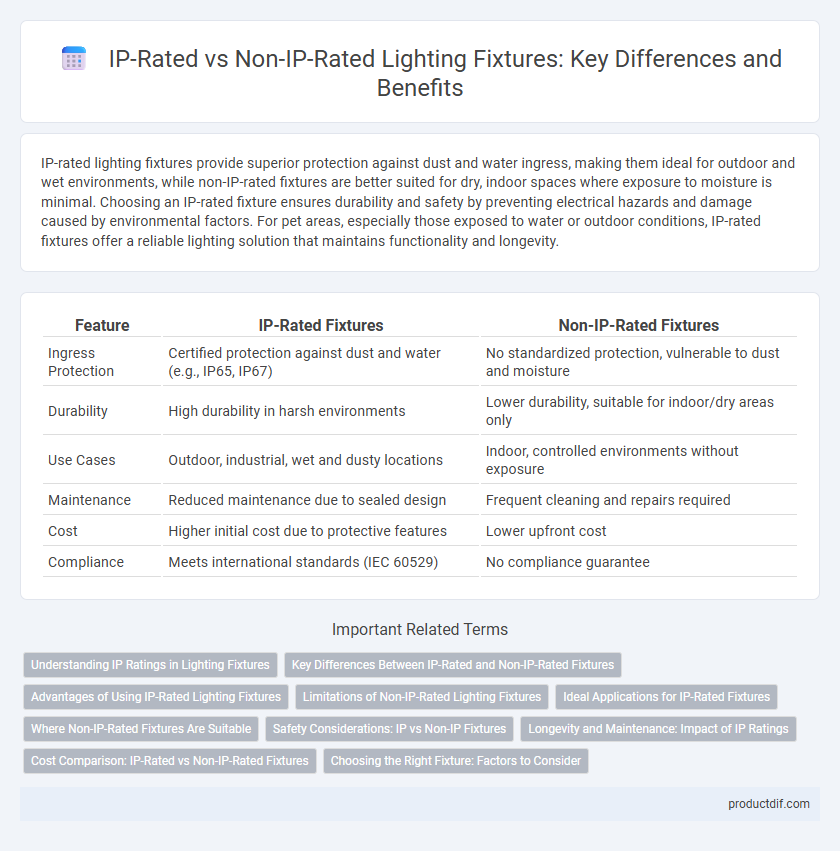IP-rated lighting fixtures provide superior protection against dust and water ingress, making them ideal for outdoor and wet environments, while non-IP-rated fixtures are better suited for dry, indoor spaces where exposure to moisture is minimal. Choosing an IP-rated fixture ensures durability and safety by preventing electrical hazards and damage caused by environmental factors. For pet areas, especially those exposed to water or outdoor conditions, IP-rated fixtures offer a reliable lighting solution that maintains functionality and longevity.
Table of Comparison
| Feature | IP-Rated Fixtures | Non-IP-Rated Fixtures |
|---|---|---|
| Ingress Protection | Certified protection against dust and water (e.g., IP65, IP67) | No standardized protection, vulnerable to dust and moisture |
| Durability | High durability in harsh environments | Lower durability, suitable for indoor/dry areas only |
| Use Cases | Outdoor, industrial, wet and dusty locations | Indoor, controlled environments without exposure |
| Maintenance | Reduced maintenance due to sealed design | Frequent cleaning and repairs required |
| Cost | Higher initial cost due to protective features | Lower upfront cost |
| Compliance | Meets international standards (IEC 60529) | No compliance guarantee |
Understanding IP Ratings in Lighting Fixtures
IP-rated lighting fixtures provide essential protection against dust, moisture, and water ingress, ensuring durability and safety in harsh environments. The IP (Ingress Protection) rating, denoted by two digits, specifies the level of protection against solid objects and liquids, with higher numbers indicating greater resistance. Selecting the appropriate IP rating is critical for applications such as outdoor lighting, industrial settings, and wet locations to prevent damage and maintain fixture performance.
Key Differences Between IP-Rated and Non-IP-Rated Fixtures
IP-rated lighting fixtures provide certified protection against dust and water, making them ideal for outdoor and harsh environments, while non-IP-rated fixtures lack this formal protection, limiting their use to controlled indoor settings. The IP rating, defined by international standards such as IEC 60529, specifies the level of ingress protection, ensuring reliability and durability under specific conditions. Non-IP-rated fixtures may be more cost-effective but often require additional safeguards to prevent damage and ensure safety in exposed conditions.
Advantages of Using IP-Rated Lighting Fixtures
IP-rated lighting fixtures provide superior protection against dust, water, and environmental elements, making them ideal for outdoor and industrial applications. Their enhanced durability extends the lifespan of the fixture, reducing maintenance costs and minimizing downtime. IP-rated fixtures also ensure consistent performance and safety in harsh conditions, meeting stringent industry standards for ingress protection.
Limitations of Non-IP-Rated Lighting Fixtures
Non-IP-rated lighting fixtures lack protection against dust and water ingress, making them unsuitable for outdoor or harsh environments where exposure to moisture or particulates is common. Their vulnerability often leads to premature failure, increased maintenance costs, and potential safety hazards in locations such as industrial sites, bathrooms, or exterior installations. Selecting fixtures without appropriate IP ratings compromises durability and performance, limiting their applications to controlled indoor environments with minimal exposure risks.
Ideal Applications for IP-Rated Fixtures
IP-rated lighting fixtures are specifically designed to withstand exposure to dust, water, and other environmental factors, making them ideal for outdoor spaces, industrial settings, and wet areas such as bathrooms, kitchens, and swimming pools. Their durable sealing prevents moisture and particulate ingress, ensuring reliable performance in harsh conditions where non-IP-rated fixtures would fail or pose safety risks. Common applications include street lighting, garden lights, manufacturing facilities, and marine environments where protection against water and dust is critical for longevity and functionality.
Where Non-IP-Rated Fixtures Are Suitable
Non-IP-rated lighting fixtures are suitable for indoor environments where exposure to dust, moisture, or water is minimal, such as residential living rooms, offices, or retail spaces. These fixtures provide adequate protection against accidental contact but lack the sealed construction required for damp or wet locations. Choosing non-IP-rated fixtures for dry, controlled settings ensures cost-effectiveness without compromising safety or functionality.
Safety Considerations: IP vs Non-IP Fixtures
IP-rated lighting fixtures provide enhanced safety by offering protection against dust, water, and foreign objects, minimizing electrical hazards in challenging environments. Non-IP-rated fixtures lack this level of sealing, increasing the risk of moisture ingress, dust accumulation, and potential short circuits, especially in outdoor or industrial settings. Choosing IP-rated fixtures ensures compliance with safety standards and reduces maintenance costs by preventing damage caused by environmental factors.
Longevity and Maintenance: Impact of IP Ratings
IP-rated lighting fixtures offer enhanced protection against dust and water ingress, significantly extending their longevity in harsh environments compared to non-IP-rated fixtures. These fixtures reduce maintenance frequency by preventing damage from moisture and debris, thus lowering repair costs and downtime. The higher the IP rating, the greater the fixture's durability and reliability, ensuring sustained performance over time in industrial, outdoor, and wet locations.
Cost Comparison: IP-Rated vs Non-IP-Rated Fixtures
IP-rated lighting fixtures typically involve higher upfront costs due to specialized materials and sealing technologies designed for protection against dust and water ingress, conforming to international IP standards such as IP65 or IP67. Non-IP-rated fixtures generally have lower initial purchase prices but may incur increased long-term expenses related to maintenance and replacement in harsh or outdoor environments. Investing in IP-rated fixtures often results in better durability and cost-efficiency over time, especially in industrial, outdoor, or wet locations requiring robust protection.
Choosing the Right Fixture: Factors to Consider
Selecting the right lighting fixture involves evaluating the IP rating to ensure durability against dust and water exposure in specific environments. IP-rated fixtures provide protection levels that enhance longevity and safety in outdoor or wet locations, whereas non-IP-rated fixtures are suitable for dry, indoor areas with minimal exposure. Consider the installation environment, moisture levels, and required protection standards to optimize both performance and compliance with safety codes.
IP-rated fixtures vs Non-IP-rated fixtures Infographic

 productdif.com
productdif.com